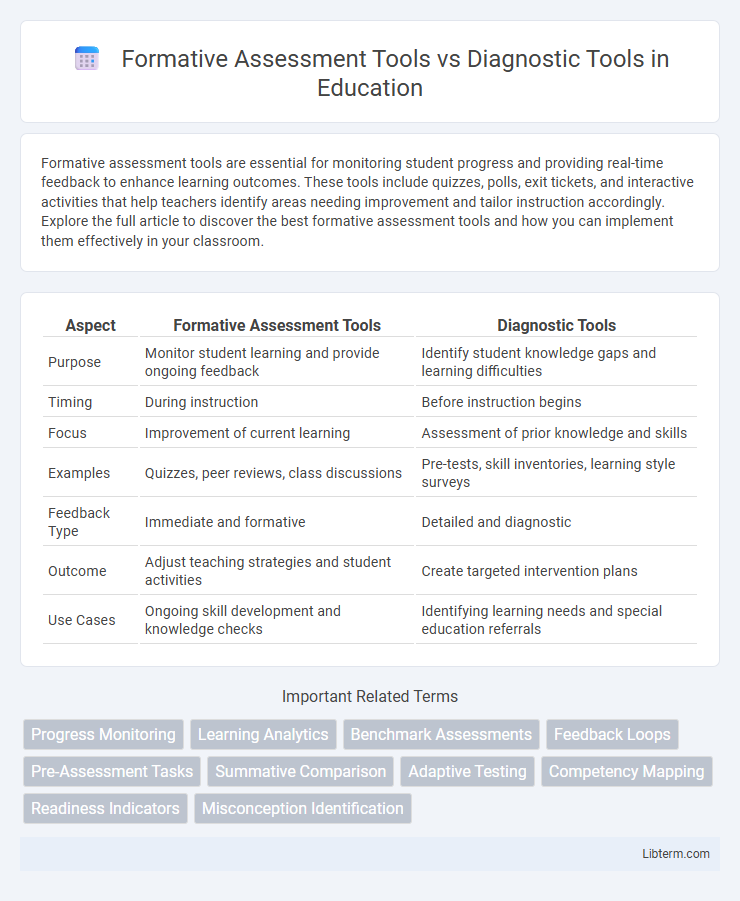Formative assessment tools are essential for monitoring student progress and providing real-time feedback to enhance learning outcomes. These tools include quizzes, polls, exit tickets, and interactive activities that help teachers identify areas needing improvement and tailor instruction accordingly. Explore the full article to discover the best formative assessment tools and how you can implement them effectively in your classroom.
Table of Comparison
| Aspect | Formative Assessment Tools | Diagnostic Tools |
|---|---|---|
| Purpose | Monitor student learning and provide ongoing feedback | Identify student knowledge gaps and learning difficulties |
| Timing | During instruction | Before instruction begins |
| Focus | Improvement of current learning | Assessment of prior knowledge and skills |
| Examples | Quizzes, peer reviews, class discussions | Pre-tests, skill inventories, learning style surveys |
| Feedback Type | Immediate and formative | Detailed and diagnostic |
| Outcome | Adjust teaching strategies and student activities | Create targeted intervention plans |
| Use Cases | Ongoing skill development and knowledge checks | Identifying learning needs and special education referrals |
Understanding Formative Assessment Tools
Formative assessment tools are designed to monitor student learning progress in real-time, providing immediate feedback that helps educators tailor instruction effectively. These tools include quizzes, exit tickets, and interactive activities that identify students' strengths and areas for improvement during the learning process. Unlike diagnostic tools, which evaluate prior knowledge before instruction begins, formative assessments support continuous learning and skill development throughout the course.
Defining Diagnostic Assessment Tools
Diagnostic assessment tools are designed to identify students' existing knowledge, skills, and learning gaps before instruction begins, providing detailed insights into individual learning needs. These assessments focus on pinpointing specific strengths and weaknesses to tailor teaching strategies effectively. Unlike formative assessment tools that monitor ongoing progress, diagnostic tools serve as a foundation for personalized intervention and curriculum planning.
Key Differences Between Formative and Diagnostic Assessments
Formative assessment tools are designed to monitor student learning progress during instruction by providing ongoing feedback that helps improve teaching strategies and learner understanding. Diagnostic tools focus on identifying students' existing knowledge, skills, and learning gaps before instruction begins, enabling targeted intervention planning. The key difference lies in the timing and purpose: formative assessments guide real-time instructional adjustments, while diagnostic assessments inform initial instructional design based on detailed learner profiles.
Purposes and Objectives of Formative Assessment
Formative assessment tools primarily aim to monitor student learning progress and provide ongoing feedback to improve teaching strategies and learner outcomes. These tools support objectives such as identifying learning gaps, promoting student self-regulation, and adapting instruction to meet learners' needs in real time. In contrast, diagnostic tools are designed to pinpoint specific strengths and weaknesses before instruction begins, enabling targeted intervention planning.
Purposes and Objectives of Diagnostic Assessment
Diagnostic assessment tools identify students' existing knowledge, skills, and misconceptions to tailor instruction effectively. Their primary objective is to pinpoint learning gaps and difficulties before or during instruction, enabling targeted interventions. These tools provide detailed insights that guide personalized teaching strategies to improve student outcomes.
Common Examples of Formative Assessment Tools
Common examples of formative assessment tools include quizzes, exit tickets, peer reviews, and observation checklists that provide real-time feedback to guide instructional adjustments. These tools differ from diagnostic tools, which are employed primarily to identify students' pre-existing knowledge, skills, and learning gaps before instruction begins. Formative assessments enhance ongoing learning processes by enabling teachers to monitor student progress and modify teaching strategies effectively.
Common Examples of Diagnostic Assessment Tools
Common examples of diagnostic assessment tools include standardized tests such as the Woodcock-Johnson Tests of Achievement and the Diagnostic Reading Assessment, which identify specific learning difficulties and skill gaps. Other widely used tools involve informal measures like teacher-created quizzes, one-on-one interviews, and observational checklists that provide detailed insight into students' strengths and weaknesses. These tools help educators tailor instruction by pinpointing precise areas needing intervention before beginning formal teaching.
Advantages and Limitations of Formative Tools
Formative assessment tools provide ongoing feedback to students and educators, enabling real-time adjustments to instruction and promoting active learning, which enhances student engagement and improves academic outcomes. These tools are advantageous for identifying learning gaps early, supporting differentiated instruction, and fostering a growth mindset; however, their effectiveness depends on consistent implementation and accurate interpretation of data, which can be time-consuming and resource-intensive. Limitations include potential teacher bias, variability in student responses, and challenges in standardizing results across diverse classroom settings.
Advantages and Limitations of Diagnostic Tools
Diagnostic tools provide detailed insights into learners' existing knowledge gaps and misconceptions, enabling targeted instructional interventions that improve learning outcomes. These tools are advantageous because they identify specific areas of difficulty early, allowing educators to customize support and prevent further misunderstanding. However, limitations include potential time consumption during assessment implementation and the risk of over-reliance on test results without considering qualitative factors such as student motivation and learning context.
Choosing the Right Assessment Tool for Learning Outcomes
Formative assessment tools such as quizzes and peer reviews provide ongoing feedback to enhance student learning and guide instructional adjustments, while diagnostic tools identify specific learning gaps before instruction begins to tailor educational strategies effectively. Selecting the right assessment tool depends on the learning outcomes targeted; formative tools are ideal for monitoring progress toward skill mastery, whereas diagnostic tools are best for detecting underlying challenges that hinder understanding. Aligning assessment choice with curriculum goals ensures precise measurement of student needs and supports targeted interventions for improved academic achievement.
Formative Assessment Tools Infographic

 libterm.com
libterm.com